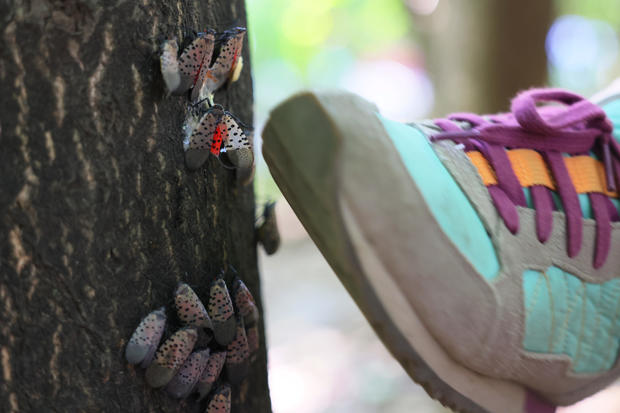They’re back. The spotted lanternflies are back.
With summer closing in fast and warm weather returning in parts of the U.S., officials are warning that rising temperatures could help lanternfly eggs hatch earlier. The invasive species is known to cause destruction to a wide range of crops and plants. And, once again, their range is growing.
“The numbers are increasing in some areas,” said Brian Eshenaur, senior extension associate of invasive species at Cornell University. “In New York City, for example, we’ll probably see more this year. And they’re expanding up the Hudson Valley. We’re also seeing them in areas as far south as North Carolina. And we are concerned about their westward expansion. You know, they can affect crops such as grapes. They’ve killed some portions of vineyards in Pennsylvania. And we want to protect especially out west where they can expand to.”
/ Getty Images
Pennsylvania was where the Chinese-native lanternfly made its American debut back in 2014, according to the USDA. Since then, the department says it’s been spotted in 13 other states: Connecticut, Delaware, Indiana, Maryland, Massachusetts, Michigan, New Jersey, New York, North Carolina, Ohio, Rhode Island, Virginia and West Virginia.
And they aren’t flying themselves to all those states. Eshenaur told CBS News humans are unwittingly helping the lanternfly see more of the country.
“I hate to say it, but it is human-assisted,” Eshenaur said. “So they are traveling on our vehicles and in trains, apparently, and on the outside.”
And the toughness and dull color of their egg masses, which the USDA describes as “mud-like,” aid in creating new infestations.
“Their egg masses are laid in the fall. They’re out there now, they’re just beginning to hatch. But they’re very resilient,” Eshenaur said. “Those egg masses can withstand subzero temperatures and if we take something that has an egg mass on it and we don’t notice it, you can see one there, it’s not very bright. It’s a light color and then it fades to a gray color eventually. If that’s on something that was outdoors and is moved to a new location in the spring when they hatch, you could have a new infestation.”
And those new infestations can have dire consequences for farmers, especially grape growers at vineyards.
“This really impacts grapes. Late in the season those adult spotted lanternflies fly into vineyards and they are an insect that feeds on the sap and they can deplete the reserves in the grape plants,” Eshenaur said. “So in the grape-producing areas particularly we are concerned, but it can be a nuisance wherever it occurs, especially in large numbers and backyard trees.”
What to do if you see a spotted lanternfly or its eggs
-
Report it to your local agricultural department
-
Scrape egg masses into a plastic zippered bag filled with hand sanitizer, then zip the bag shut and dispose of it properly
-
Steel yourself, harden your heart, and stomp on adult spotted lanternflies until they’re dead
Michael M. Santiago / Getty Images
That’s what the USDA’s website says, though not with as much pizazz.
“Spotted lanternfly egg masses are about an inch long and resemble a smear of mud. If found in an area known to have an SLF population, residents should crush them and scrape them off. Travelers passing through SLF quarantine areas should thoroughly check their vehicles, trailers, and even the clothes they are wearing to avoid accidentally moving the spotted lanternfly from a quarantine area to somewhere new.”
Eshenaur also said killing the lanternflies is the best course of action, but if you’re using traps you’ll want to take extra steps.
“We definitely don’t want to move them,” Eshenaur said. “If you see them in a local area, it is a good idea to kill them to prevent them from laying eggs that will show up next year. But traps can be very effective and you can capture a lot through traps. However, with the sticky traps we want to make sure we have something covering that because when the spotted lantern fly lands there, woodpeckers get interested in that and there have been cases when we’ve captured birds inadvertently. So there are some traps. There is a circle trap you can find information about online. And those sticky traps can be okay, but we want to cover them with some kind of screen.”
“If you find one of those egg masses and you scrape that off, put it into a bag and put some rubbing alcohol in there, that will kill those.” Eshenaur continued, “We definitely don’t want to move the egg masses.”
/ Getty Images
Signs of spotted lanternfly infestation include plants that ooze or weep and have a fermented odor, buildup of sticky fluid or honeydew on plants and on the ground underneath infested plants and sooty mold on infested plants.
If you’re in a state outside a spotted lanternfly quarantine area and see one of the pests, the USDA says you should take a picture of it and note the location to report it to your state Department of Agriculture before killing it.


















































